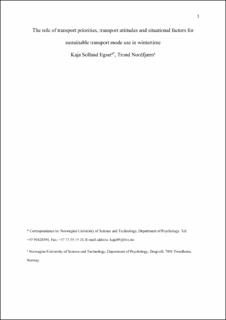| dc.contributor.author | Egset, Kaja Solland | |
| dc.contributor.author | Nordfjærn, Trond | |
| dc.date.accessioned | 2022-03-07T14:01:18Z | |
| dc.date.available | 2022-03-07T14:01:18Z | |
| dc.date.created | 2019-02-10T13:10:38Z | |
| dc.date.issued | 2019 | |
| dc.identifier.citation | Transportation Research Part F: Traffic Psychology and Behaviour. 2019, 62 473-482. | en_US |
| dc.identifier.issn | 1369-8478 | |
| dc.identifier.uri | https://hdl.handle.net/11250/2983492 | |
| dc.description.abstract | The aim of this study was to investigate transport priorities as a predictor over and above transport attitudes and situational factors, for the use of active and public transport (PT) to and from university among Norwegian university students in wintertime. A cross-sectional self-completion survey was carried out with 441 university students (229 females, 206 males), at two university campuses in Trondheim (Dragvoll and Gløshaugen), Norway. Transport priorities added to the explained variance above and beyond situational factors and transport attitudes. The transport priority of Exercise was associated with increased active transport use and the priority of flexibility was associated with decreased active transport use. In line with previous research, a more positive environmental attitude was related to increased active transport use as well. Among psychological factors, the transport attitude of comfort in PT, related to lower levels of PT use, possibly indicating dissatisfaction with using this mode. Overall, psychological factors (transport priorities, transport attitudes) contributed less explained variance of sustainable transport use, than situational factors (e.g. campus location, travel distance). Reminding students of the health and environmental benefits of active transport might be a promising way to promote this transport mode. Improving PT comfort might also promote continued usage of this mode in later life. However, increased sustainable transport mode use during winter appear to also depend on reducing situational constraints (e.g. clear snow on available walking and bicycling paths, improve infrastructure). | en_US |
| dc.language.iso | eng | en_US |
| dc.publisher | Elsevier | en_US |
| dc.rights | Attribution-NonCommercial-NoDerivatives 4.0 Internasjonal | * |
| dc.rights.uri | http://creativecommons.org/licenses/by-nc-nd/4.0/deed.no | * |
| dc.title | The role of transport priorities, transport attitudes and situational factors for sustainable transport mode use in wintertime | en_US |
| dc.type | Journal article | en_US |
| dc.type | Peer reviewed | en_US |
| dc.description.version | acceptedVersion | en_US |
| dc.rights.holder | © 2019. This manuscript version is made available under the CC-BY-NC-ND 4.0 license | en_US |
| dc.source.pagenumber | 473-482 | en_US |
| dc.source.volume | 62 | en_US |
| dc.source.journal | Transportation Research Part F: Traffic Psychology and Behaviour | en_US |
| dc.identifier.doi | 10.1016/j.trf.2019.02.003 | |
| dc.identifier.cristin | 1675381 | |
| cristin.unitcode | 194,67,40,0 | |
| cristin.unitname | Institutt for psykologi | |
| cristin.ispublished | true | |
| cristin.fulltext | postprint | |
| cristin.qualitycode | 1 | |

